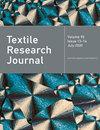纺织品成分、结构和处理对洗涤过程中微塑料释放的影响:综述
IF 1.9
4区 工程技术
Q2 MATERIALS SCIENCE, TEXTILES
引用次数: 0
摘要
本研究对纺织品特性(包括纺织品含量(纤维成分)、纱线结构、材料结构和处理类型)在洗涤过程中对纺织品中微塑料释放的影响进行了严格审查。迄今为止,研究的主要重点是洗涤参数,而不是纺织品的内在特性。本综述的研究结果表明,与纯合成织物相比,天然织物、人造织物和混合成分织物往往会释放出更多的微纤维。在有关回收合成织物释放微塑料的研究中,观察到了不同的结果。与针织织物相比,机织织物释放的微塑料较少。不过,纱线结构对微塑料释放的影响显然大于纺织品成分或结构,高捻长丝纱线可减少微塑料的形成。机械整理往往会增加微塑料的释放,而合成和生物可降解整理则会减少微塑料的释放,但它们的可持续性和耐久性方面还需要进一步研究。不同类型的染料对微塑料释放的影响仍不清楚。本文所述的所有纺织品特性在微塑料研究中都具有举足轻重的作用。忽视其中任何一个细节的重要性都会使微塑料减缓策略的制定变得更加复杂。本文章由计算机程序翻译,如有差异,请以英文原文为准。
Impact of textile composition, structure, and treatment on microplastic release during washing: a review
This research critically reviewed the influence of textile characteristics, including textile content (fiber composition), yarn construction, material structure, and treatment type, on microplastic release from textile products during washing. To date, the predominant focus of research has been on the washing parameters rather than the intrinsic characteristics of textiles. The findings of this review revealed that natural, man-made, and mixed-composition fabrics tend to release more microfibers compared to pure synthetic fabrics. Divergent results have been observed in studies on the release of microplastics from recycled synthetic fabrics. Woven fabrics release less microplastic compared to knitted fabrics. However, it is evident that yarn construction has more impact on microplastic release than textile composition or structure, and high-twist filament yarns reduce microplastic formation. Mechanical finishes tend to enhance microplastic release, while synthetic and biodegradable reduce it, but their sustainability and durability aspects need further investigation. The impact of different types of dyes on microplastic release remains unclear. All of the textile characteristics specified in this article are of pivotal importance in microplastic research. Overlooking the significance of any of these details can complicate the development of microplastic mitigation strategies.
求助全文
通过发布文献求助,成功后即可免费获取论文全文。
去求助
来源期刊

Textile Research Journal
工程技术-材料科学:纺织
CiteScore
4.00
自引率
21.70%
发文量
309
审稿时长
1.5 months
期刊介绍:
The Textile Research Journal is the leading peer reviewed Journal for textile research. It is devoted to the dissemination of fundamental, theoretical and applied scientific knowledge in materials, chemistry, manufacture and system sciences related to fibers, fibrous assemblies and textiles. The Journal serves authors and subscribers worldwide, and it is selective in accepting contributions on the basis of merit, novelty and originality.
 求助内容:
求助内容: 应助结果提醒方式:
应助结果提醒方式:


